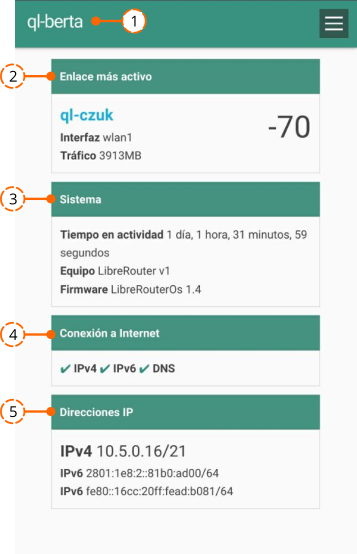This screen provides basic information on equipment performance data.

- Header
Displays the name of the base node and the icon to display the menu. - Most active link
Displays the link information between the base node and the node with which it communicates most directly within the network.
It then indicates through which interface this link is made: wlan1 or wlan2. wlan1 refers to the antenna-radio labeled with number 1, and wlan2 to radio antenna 2.
It then reports the amount of data measured in megabytes (MB) that was transferred between the two nodes since the last time they were interconnected (which can be a little or a lot of time).
On the right it shows the link quality between the two computers.
It provides the possibility to quickly assess whether it is necessary to reorient the node’s antennas (see the alignment screen, below).
- System
Displays the uptime of the base node, in other words, how long it has been on.
This information is useful for determining whether a node restarts itself, without the
intention of the people maintaining the network.
It also informs which version is.
- Internet connection
Provides the following information:
- IPV4
Indicates whether or not there is sending and receiving data linked to the node’s IPv4 address. That is, if there is communication with the Internet using IPv4.
- IPV6
Indicates whether or not there is sending and receiving data linked to the node’s IPv6 address.
IPv6 address of the node. That is, if there is communication with the Internet using IPv6.
- DNS
Indicates whether or not our node is able to access the domain name server, which relates the names of the websites with the IP number that hosts them.
The red cross ✘ indicates that the service is not available while the green check mark ✔ indicates that it is available.
- IPV4
- IP addresses
Provides the IP numbers that the base node uses to be identified within the network.
Often useful when monitoring and diagnosing the network.

